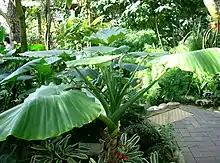Alocasia odora
Alocasia odora (also called night-scented lily, Asian taro or giant upright elephant ear) is a flowering plant native to East and Southeast Asia (Japan, China, Indochina, Assam, Bangladesh, Borneo, Taiwan).[1][2] In Manipur, its local name is Hoomu. Alocasia odora (called Ray) can be used as medicine for the treatment of common cold in North Vietnam.[3]
| Alocasia odora | |
|---|---|
 | |
| Scientific classification | |
| Kingdom: | Plantae |
| Clade: | Tracheophytes |
| Clade: | Angiosperms |
| Clade: | Monocots |
| Order: | Alismatales |
| Family: | Araceae |
| Genus: | Alocasia |
| Species: | A. odora |
| Binomial name | |
| Alocasia odora | |
| Synonyms[1] | |
The plant is actually inedible when raw because of needle-shaped raphides (calcium oxalate crystals) in the plant cells.[4] In Japan, there are several cases of food poisoning by accidental consumption. The Ministry of Health, Labour and Welfare warned not to eat A. odora (Kuwazuimo), which looks similar to edible Colocasia gigantea (Hasuimo) or Colocasia esculenta (Satoimo).[5][6][7]
This plant is grows to about 0.5–1.6 m high, with rhizomes of about 4–10 m high and 3–5 cm wide.[8] The leaves are big and blade-shaped, ovate, light green with cordate base. The petioles are 0.3–1.0 m long, with the lower parts clasped around the stem.[9]
The plant is a member of the genus Alocasia, and is thus related to taro.
References
- Kew World Checklist of Selected Plant Families
- "Alocasia odora (Lodd.) Spach., 1846". TaiBNET. Taiwan: Biodiversity Research Centre, Academia_Sinica. Retrieved 2016-05-01.
- MATSUDA M and NAWATA E (2002) "Taro in Northern Vietnam : Its Uses, Cultivation, and Genetic Variation" Japanese Journal of Tropical Agriculture, 46/4, p.252
- Jeong Mi Moon, et al. 'Toxicities of raw Alocasia odora', Human & Experimental Toxicology. Abstract
- "「クワズイモ」誤食に注意呼び掛け 厚労省 高知・四万十市で食中". 日本経済新聞.
- 後藤勝実、月岡淳子. "クワズイモ". 自然毒のリスクプロファイル. 厚生労働省.
- さいたま市保健福祉局 健康科学研究センター 生活科学課 (2012年11月19日). "食べられないイモ『クワズイモ』". さいたま市.
- "Alocasia Odora Variegata - Everything You Need to Know". Gardening it. 2020-04-08. Retrieved 2021-07-23.
- Tanaka, Yoshitaka; Van Ke, Nguyen (2007). Edible Wild Plants of Vietnam: The Bountiful Garden. Thailand: Orchid Press. p. 29. ISBN 978-9745240896.